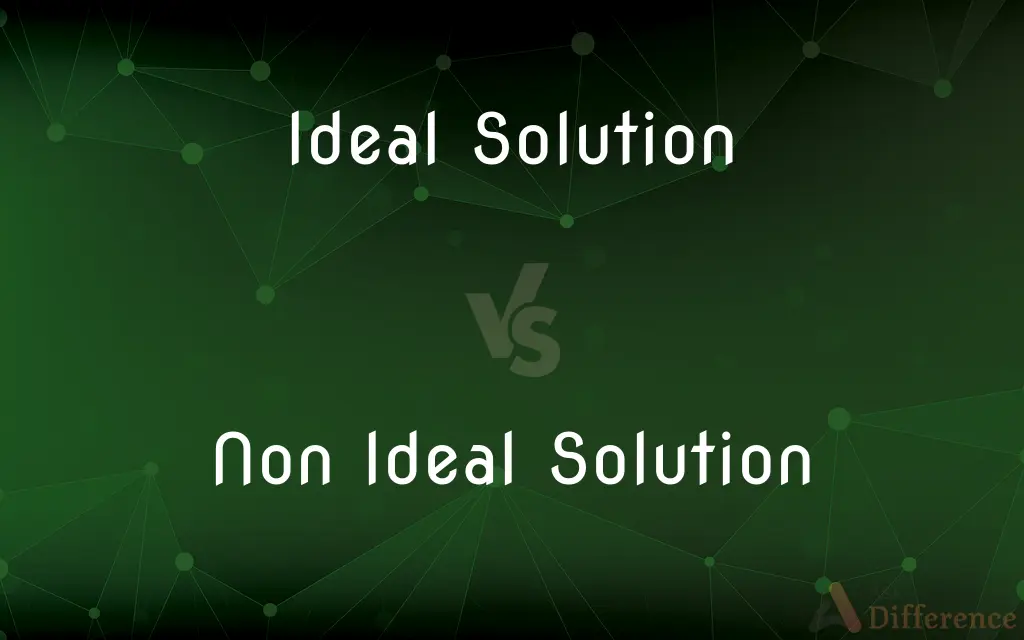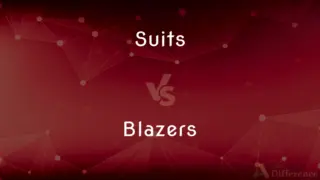Ideal Solution vs. Non Ideal Solution — What's the Difference?
By Tayyaba Rehman — Published on November 10, 2023
Ideal Solution follows Raoult's law and has no interaction between components; Non Ideal Solution has deviations due to interactions.

Difference Between Ideal Solution and Non Ideal Solution
Table of Contents
ADVERTISEMENT
Key Differences
Ideal Solution and Non Ideal Solution are both terminologies used in the realm of physical chemistry, specifically when addressing solutions. An Ideal Solution is one in which the interactions between the molecules of the different components are the same as the interactions between the molecules of the pure components. In such solutions, behavior is predictable and follows Raoult's law, meaning that the vapor pressure of a component is directly proportional to its mole fraction.
Contrarily, a Non Ideal Solution is one that does not obey Raoult's law. In these solutions, the interactions between different components can either be more attractive or more repulsive than those in the pure components. This deviation results in a difference between the observed vapor pressure and the one predicted by Raoult's law.
It's pivotal to recognize that while the Ideal Solution serves as a standard model in thermodynamics, most real-world solutions tend to display non-ideal behavior to some extent. The reason behind the non-ideality often lies in molecular sizes, shapes, and charges leading to varied interactions.
In practical applications, understanding the distinction between Ideal Solution and Non Ideal Solution is essential. For instance, when designing separation processes or when studying the thermodynamic properties of mixtures, knowing the nature of the solution—whether it's ideal or non-ideal—can be crucial.
The presence of an azeotrope, a mixture that boils at a constant temperature producing a vapor with the same composition as the liquid, can often indicate Non Ideal Solution behavior. It's phenomena like these that emphasize the rich complexity introduced by non-ideality in solutions.
ADVERTISEMENT
Comparison Chart
Definition
Solution that obeys Raoult's law
Solution that deviates from Raoult's law
Molecular Interactions
Similar to those in pure components
Either stronger or weaker than in pure components
Real-world occurrence
Rare
Common
Vapor Pressure Behavior
Predictable by Raoult's law
Deviates from predictions
Example Phenomenon
Absence of azeotropes
Presence of azeotropes
Compare with Definitions
Ideal Solution
Theoretical solutions used for reference in thermodynamics.
In textbooks, an Ideal Solution is often used to simplify complex calculations.
Non Ideal Solution
Mixtures with interactions different from pure components.
Mixing chloroform and acetone yields a Non Ideal Solution due to differing molecular forces.
Ideal Solution
Solution with interactions similar to pure components.
Ethanol and ethyl ether create an Ideal Solution due to similar molecular interactions.
Non Ideal Solution
Solutions that exhibit unexpected vapor pressures.
A Non Ideal Solution might boil at a different temperature than anticipated.
Ideal Solution
A solution that follows Raoult's law.
Benzene and toluene form an Ideal Solution when mixed.
Non Ideal Solution
Results from stronger or weaker molecular forces than expected.
When non-polar and polar liquids mix, they often form Non Ideal Solutions.
Ideal Solution
Mixtures with no excess or deficit in vapor pressure.
The Ideal Solution does not exhibit positive or negative deviations in vapor pressures.
Non Ideal Solution
Often contains azeotropes in its phase diagram.
The Non Ideal Solution of ethanol and water forms an azeotrope.
Ideal Solution
A mixture showing no deviation from expected behavior.
The vapor pressure of an Ideal Solution of hexane and heptane can be easily calculated.
Non Ideal Solution
A solution that deviates from Raoult's law.
Water and aniline form a Non Ideal Solution when mixed.
Common Curiosities
What is an Ideal Solution in simple terms?
An Ideal Solution is one that behaves predictably and follows Raoult's law.
Are most real-world solutions ideal or non-ideal?
Most real-world solutions exhibit Non Ideal Solution behavior.
How does a Non Ideal Solution differ?
A Non Ideal Solution deviates from Raoult's law due to different molecular interactions.
Why is understanding these solutions important?
It's vital for applications like separation processes and studying thermodynamic properties.
Does an Ideal Solution show any deviation in vapor pressure?
No, an Ideal Solution shows no deviation from expected vapor pressures.
What's an azeotrope and which type of solution does it indicate?
An azeotrope is a mixture that boils without changing composition, indicating a Non Ideal Solution.
Can the behavior of a solution change with concentration?
Yes, concentration changes can shift a solution from ideal to non-ideal behavior.
Can you give an example of an Ideal Solution?
Benzene and toluene, when mixed, form an Ideal Solution.
What causes a solution to be non-ideal?
Differences in molecular sizes, shapes, and charges can lead to a Non Ideal Solution.
How do molecular interactions affect solution behavior?
They determine whether the solution is ideal or non-ideal based on interaction strength.
Is the concept of Ideal Solution purely theoretical?
While based on theory, some real-world solutions can closely approximate Ideal Solution behavior.
Are azeotropes found in Ideal Solutions?
No, azeotropes are indicative of Non Ideal Solutions.
What is Raoult's law?
Raoult's law states that the vapor pressure of a component in a solution is proportional to its mole fraction.
Can a solution switch between being ideal and non-ideal?
While rare, changes in conditions or composition can shift solution behavior.
Why do some mixtures form Non Ideal Solutions?
Due to variations in molecular interactions when different substances are mixed.
Share Your Discovery

Previous Comparison
Suits vs. Blazers
Next Comparison
Redmi 2 vs. Redmi 2 PrimeAuthor Spotlight
Written by
Tayyaba RehmanTayyaba Rehman is a distinguished writer, currently serving as a primary contributor to askdifference.com. As a researcher in semantics and etymology, Tayyaba's passion for the complexity of languages and their distinctions has found a perfect home on the platform. Tayyaba delves into the intricacies of language, distinguishing between commonly confused words and phrases, thereby providing clarity for readers worldwide.












































